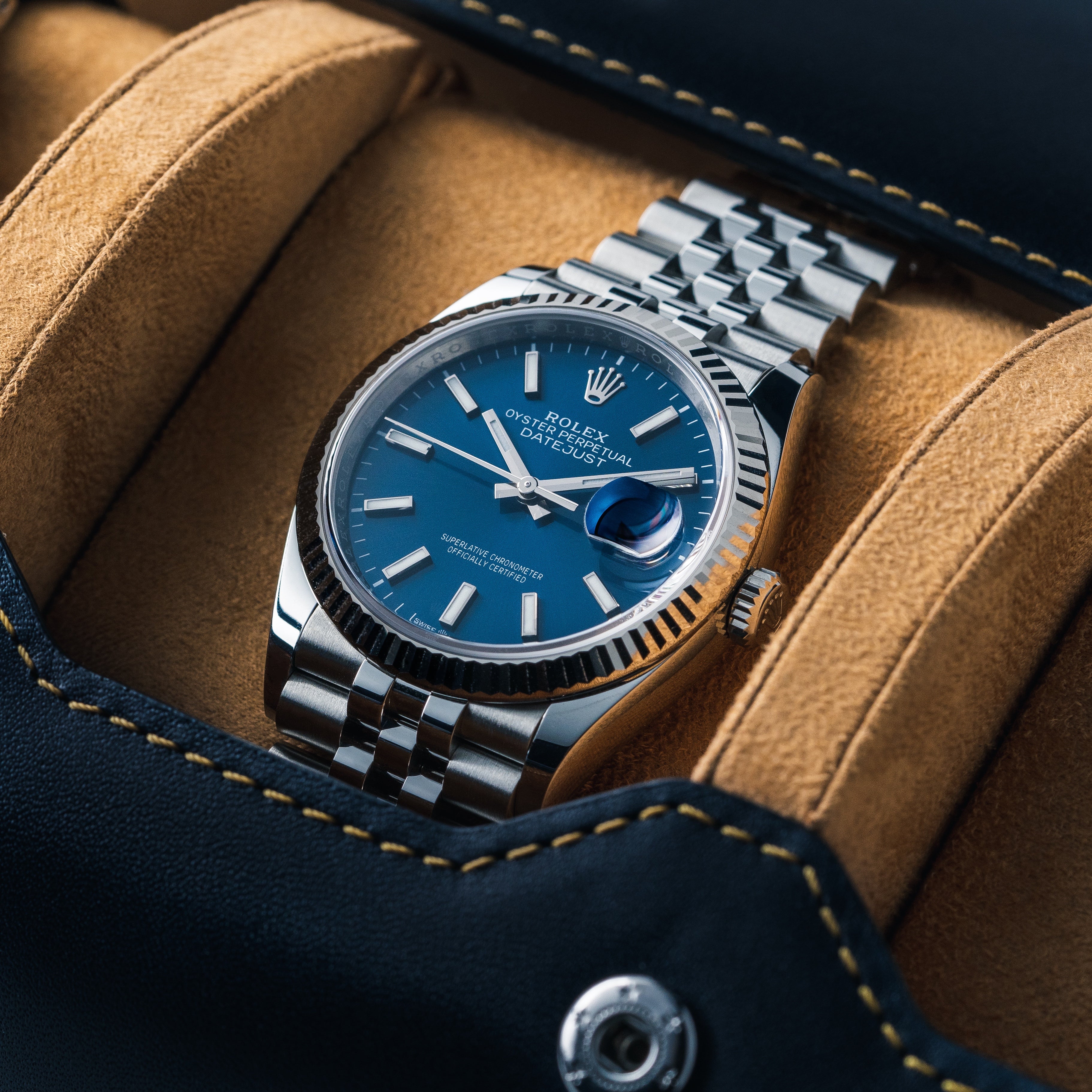The Rolex Datejust II vs. The Datejust 41
Rolex has always been an industry trailblazer, inventing the first waterproof wristwatch in 1926 via their innovative Oyster case. The Datejust came to market in 1945 and featured the world’s first automatically changing date mechanism. The inaugural model featured a 36mm case, followed by a women’s size and then a mid-size option. Surprisingly, it wasn’t until recently that Rolex finally added a more contemporary 41mm alternative to the Datejust catalog. The first model, the Datejust II, hit the market in 2009 and remained in production for a few years before it was discontinued and replaced by the Datejust 41 in 2016, featuring the same 41mm case size. The two models are often confused for each other but are also very different watches. Let’s take a closer look at what sets them apart.

Features: Case, Bezel, Dial, and Bracelet
The specs for both models are the same, yet the Datejust II has a more robust appearance than the current-production Datejust 41. Technically, both models have 41mm cases and a thickness of about 12mm. However, the Datejust 41 is overall more refined with slimmed-down features. For example, the case on the Datejust 41 is slightly thinner than the Datejust II with a difference of less than a millimeter. We see a similar difference in the lugs, with the Datejust 41 sporting more tapered and less boxy lugs that are also thinner by just a fraction of a millimeter. Although similar in size, the lugs appear much different when both models are side-by-side. This marginal difference isn’t just aesthetically significant, either. It can also affect how aftermarket straps fit both models. When Rolex developed the Datejust 41, they also thinned out the hour markers and the bezel, making the dial appear larger.
You can see the difference in features in the image below with the Datejust 41 on the left and the Datejust II on the right.

Rolex only produced the Datejust II on the sportier three-link Oyster bracelet, while the current production Datejust 41 is sold on both the Oyster bracelet and the dressier five-link Jubilee bracelet. Regarding metal finishes, Rolex produced both models in stainless steel, steel with white gold (White Rolesor), and steel with yellow gold (Yellow Rolesor). The Datejust 41 is the only model between the two produced in Everose Rolesor, which pairs steel with rose gold.

The Datejust 41 ref. 126300 vs. Rolex Datejust II ref. 116300.
Overall, the newer-model Datejust 41 has a more refined look and feel on the wrist, while the Datejust II appears larger with chunkier features. They both hold a special place in Rolex history with their own distinctive aesthetics.
Movement: Caliber 3136 vs. Caliber 3235
Another notable significance between the Datejust II and Datejust 41 is the movement powering each watch. The Datejust II is powered by the caliber 3136, which Rolex produced exclusively for that watch. The Datejust 41 is equipped with Rolex’s impressive caliber 3235, which has dethroned the long-reigning caliber 3135 used throughout the Rolex catalog. Caliber 3136 has a power reserve of 48 hours, while the caliber 3235 boasts a longer 70-hour power reserve. The caliber 3235 is also more efficient, boasting a new skeletonized Chronergy escapement and a newer self-winding module and mainspring. Additionally, both movements benefit from Rolex’s patented Paraflex shock absorbers and Parachrom hairspring.
Datejust 41mm Blue Dial vs White Dial - A Sneaky Detail
One more element, to add a bit more confusion (or clarity, depending on how you look at it) is that the blue dialed version and the white dialed version of the Datejust 41 are actually slightly different if you look closely at the dial.
What you will notice if you look closely, is that the white dialed version (shown above) doesn't have the Rolex coronet or "crown" between the "Swiss" and "Made" at the 6:00 marker, but the blue dial does.

The Rolex crown between the "Swiss" and the "Made" came about in 2018 and was meant to signify that the watch has the newest movement. Nearly all new Rolex releases since this time will have the crown at the 6:00 marker. However, even though the white dialed Datejust 41, 126300 does have the new movement inside, it was produced before the addition of the crown between the "Swiss" and the "Made."
To summarize: the white dial Datejust 126300 does have the new movement, (calibre 3235), but it was made prior to 2018, whereas the blue dial is a post-2018 production run, which is why you will see the teeny crown at the 6:00 marker. It is unknown if this minor detail will make a difference to collectors, however, what we know about watch collectors is that generally every little detail does matter to them. Perhaps some may find more value in an original, first production run model, while others may assign more value to a more current model of the Datejust 41. In the end, it's probably more a matter of personal preference.

Rolex Datejust 41mm watch inside of an Everest leather watch roll.
However, why this information is included in this article is to say that if you are looking at a Datejust watch, and it's 41mm, and you are trying to ascertain if it's a Datejust 41 or a Datejust II, one key feature that may help you is to look for the Rolex coronet crown in between "Swiss" and "Made." While not all Datejust 41s will have that crown, absolutely no Datejust II's will. So if you see the crown at that 6:00 spot, you can be certain the watch you're looking at is not a Datejust II.
Now that you know the difference between the two watches, which edition of the larger Datejust is your favorite? The slightly more refined Datejust 41 or the robust Datejust II?









Leave a comment